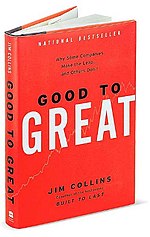-
(인문학) <Good to Great> by Jim C. Collins사람되기/인문학 2016. 11. 23. 10:51
출처: https://en.wikipedia.org/wiki/Good_to_Great
Good to Great
From Wikipedia, the free encyclopediaGood to Great: Why Some Companies Make the Leap... and Others Don't  Front cover
Front coverAuthor Jim C. Collins Country United States Language English Subject Corporate strategy Genre Non-fiction Publisher William Collins Publication dateOctober 16, 2001 Media type Hardcover Pages 320 ISBN 978-0-06-662099-2 OCLC 46835556 658 21 LC Class HD57.7 .C645 2001 Good to Great: Why Some Companies Make the Leap... and Others Don't is a management book by Jim C. Collins that describes how companies transition from being good companies to great companies, and how most companies fail to make the transition. The book was published on October 16, 2001. "Greatness" is defined as financial performance several multiples better than the market average over a sustained period. Collins finds the main reason certain companies become great is they narrowly focus the company’s resources on their field of key competence.
The book was a bestseller, selling four million copies and going far beyond the traditional audience of business books.[1]
Contents
[hide]Writing[edit]
Collins used a large team of researchers who studied "6,000 articles, generated more than 2,000 pages of interview transcripts and created 384 megabytes of computer data in a five-year project".[2]Top members of this research team were
- Brian J.Bagley
- Lane Hornung
- Vicki Mosur Osgood
- Scott Cederberg
- Christine Jones
- Alyson Sinclair
- Anthony J.Chirikos
- Scott Jones
- Peter Van Genderen
- Jenni Cooper
- Stefanie A.Judd
- Paul Weissman
- Duane C.Duffy
- Brian C.Larsen
- Leigh Wilbanks
- Eric Hagen
- Weijia (Eve) Li
- Amber L.Young
- Morten T.Hansen
- Nicholas M.Osgood
Seven characteristics of companies that went from "good to great"[edit]
- Level 5 Leadership: Leaders who are humble, but driven to do what's best for the company.
- First Who, Then What: Get the right people on the bus, then figure out where to go. Finding the right people and trying them out in different positions.
- Confront the Brutal Facts: The Stockdale paradox—Confront the brutal truth of the situation, yet at the same time, never give up hope.
- Hedgehog Concept: Three overlapping circles: What lights your fire ("passion")? What could you be best in the world at ("best at")? What makes you money ("driving resource")?
- Culture of Discipline: Rinsing the cottage cheese.
- Technology Accelerators: Using technology to accelerate growth, within the three circles of the hedgehog concept.
- The Flywheel: The additive effect of many small initiatives; they act on each other like compound interest.
Great companies[edit]
Collins finds eleven examples of "great companies" and comparators, similar in industry-type and opportunity, but which failed to achieve the good-to-great growth shown in the great companies:
Great Company Comparator Abbott Laboratories Upjohn Circuit City Stores Silo Fannie Mae Great Western Bank Gillette Company (now a Procter & Gamble brand) Warner-Lambert Co Kimberly-Clark Scott Paper Company Kroger A&P (declared bankruptcy in 2010 and 2015; all supermarkets sold or shut down in 2015) Nucor Bethlehem Steel Philip Morris R. J. Reynolds Pitney Bowes Addressograph Walgreens Eckerd Wells Fargo Bank of America Unsustained Companies[edit]
Collins includes 6 examples of companies that did not sustain their change to greatness. These companies, "... are looked at separately as a clump":[3]
Unsustained Comparisons Burroughs Chrysler Harris Hasbro Rubbermaid Teledyne Response[edit]
The book was "cited by several members of The Wall Street Journal's CEO Council as the best management book they've read."[4]
Publishers Weekly called it "worthwhile", although "many of Collins' perspectives on running a business are amazingly simple and commonsense".[2] Similarly Holt and Cameron state the book provides a "generic business recipe" that ignores "particular strategic opportunities and challenges."[5]
Steven D. Levitt notes that some of the companies selected as "great" have since gotten into serious trouble, such as Circuit City, while only Nucor had "dramatically outperformed the stock market" and "Abbott Labs and Wells Fargo have done okay". He further states that investing in the portfolio of the 11 companies covered by the book, in the year of 2001, would actually result in underperforming the S&P 500[6] Levitt concludes that books like this are "mostly backward-looking" and can't offer a guide for the future."[7]
Collins reaffirmed that "The books never promised that these companies would always be great, just that they were once great."[8]
See also[edit]
References[edit]
- ^ Bryant, Adam (May 23, 2009). "For This Guru, No Question Is Too Big". New York Times.
- ^ a b "GOOD TO GREAT: Why Some Companies Make the Leap... And Others Don't (Review)". September 3, 2001. Retrieved 2012-07-13.
- ^ http://www.audiobooks.com/audiobook/good-to-great-why-some-companies-make-the-leap-and-others-dont/83046
- ^ Alan Murray (2010). The Wall Street Journal Essential Guide to Management. New York: HarperCollins. p. 11. ISBN 978-0-06-184033-3.
- ^ Holt, Douglas; Cameron, Douglas (2010). Cultural Strategy. Oxford University Press. ISBN 978-0-19-958740-7.
- ^ http://blog.asmartbear.com/business-advice-plagued-by-survivor-bias.html
- ^ Levitt, Steven D. (2008-07-28). "From Good to Great … to Below Average". Freakonomics.
- ^ Clint Greenleaf (September 14, 2009). "Paranoia: Your Best Friend". Inc. (magazine). Retrieved 2015-07-17.
External links[edit]
Good To Great -w.pdf0.36MB'사람되기 > 인문학' 카테고리의 다른 글
(인문학/오디오) Good to Great Audiobook Part 2 / Jim Collins (0) 2016.11.23 (인문학/오디오) Good to Great Audiobook Part 1 / Jim Collins (0) 2016.11.23 (인문학) Gunboat diplomacy (포함砲艦외교) (0) 2016.11.23 (인문학) The Great Game 그레이트 게임 (0) 2016.11.21 (인문학) Western Hemisphere Institute for Security Cooperation 안보협력 위한 서반구 연구소 (0) 2016.11.21